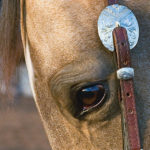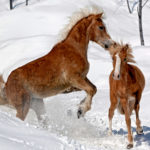We ride horses across the entire spectrum of their speed, from the collection of dressage to the extension of racing. As your horse speeds up, you need to shorten your stirrups and bend over. Photos like those above give you a visual for your position at various speeds.
 Credit: © Amy K. Dragoo, © Arnd Bronkhorst, © Amy K. Dragoo, © Bob Coglianese Photos Inc. Left to Right: © Amy K. Dragoo, © Arnd Bronkhorst, © Amy K. Dragoo, © Bob Coglianese Photos Inc.
Credit: © Amy K. Dragoo, © Arnd Bronkhorst, © Amy K. Dragoo, © Bob Coglianese Photos Inc. Left to Right: © Amy K. Dragoo, © Arnd Bronkhorst, © Amy K. Dragoo, © Bob Coglianese Photos Inc.1. When you are riding dressage, I want your back to form a right angle with your horse’s back. Edward Gal, shown here at the 2010 World Equestrian Games in Lexington, Kentucky, with Moorlands Totilas, only appears to have his shoulders behind his hips. Due to the horse’s engagement, his hips are lower than his shoulders. The relationship between the backs of horse and rider is still correct.
2. Jeroen Dubbeldam of the Netherlands and Zenith SFN were in team and individual gold-medal form at the 2014 World Equestrian Games in Normandy, France. With shorter stirrups than Edward Gal, Jeroen has a 90-degree angle behind his knee and his shoulders are in front of his hips. I want you to be seated in the approach to obstacles because you will be more stable, have wider range of influence over your horse and have a better chance of seeing your stride. Just make sure you sit down, not back.
3. I love Mary King’s galloping position aboard King’s Temptress in this photo taken at the 2011 Rolex Kentucky Three-Day Event in Lexington. Mary is in the right place at the right time: She is close to the saddle with her seat but allowing enough space for her horse’s back to work freely underneath her. Notice her vertical stirrup leather and the springlike action of her knees, which enable her to float above her horse’s back. Her speed is much faster than the previous two riders’, her hip angle is closed and her shoulders are in front of her knees.
4. Although very different from the previous positions, José Ortiz’s position is, again, the right position for the right time. Photographed at the 2014 Ballerina Stakes, in Saratoga, New York, Artemis Agrotera is obviously flying down the stretch, and José is poised above her. His back is parallel to her back, his stirrup leather is vertical and the softness of his hands is a direct result of his superb lower-leg position.
The perfect position, like a unicorn, is a myth. Instead of worrying about finding it, I want you to concentrate on having the right position right now. Your position should do more than keep you attached to your horse. It should keep you in balance and harmony with him at all times.
Because your position is such an important part of your riding, I have written several columns about it over the years, including a detailed discussion of your lower-leg position. In simplistic terms, when we talk about your lower leg, keep your stirrup leather vertical and your lower-leg position will never let you down. (If you want to see what I mean, look at the graphic on my “Vertical Is Absolute” column at www.PracticalHorsemanMag.com. Since that column talked exclusively about your lower leg, this month I am going to discuss your upper body.
Your upper-body position is more complex than your lower-leg position for two reasons. The first is that the angle formed at your hip between your thigh and your upper body, which I call “the hip angle,” is not fixed due to the changing speed of your horse. In addition, you really have two upper-body positions—one for dressage and one for stadium and cross-country jumping.
Your Upper Body on the Flat
As usual, I am going to talk about your dressage first—and as usual, before I stick my neck out in print, I always refer to my source materials. Wilhelm Müseler’s famous Riding Logic is my go-to book for dressage information. Müseler thought the rider’s position so important that he did not include a photo of a rider in a good position—not because he could not find any good photos but rather to highlight the fact that the dressage position must be flexible, not frozen in adherence to some preconceived notion of “perfect.” Although I try to use photos and graphics to illustrate my writings, Müseler had a point. Because your horse is moving, your position must move with him.
Let me try describing your most effective dressage position in a slightly different way: Visualize your horse’s back as a horizontal line while your back forms a vertical line. Whatever dressage work you ask your horse to do, the intersection of those two lines should form a right angle. This position explains why upper-level dressage riders appear to have their shoulders behind their hips. They are not leaning back; they are maintaining a right angle between their body and their horse’s back, even as the horse lowers his croup to engage and collect.
I have often referred to your dressage position in earlier columns as a three-point seat because the two seat bones and the pubic bone are the foundation of your position for this discipline. In controlled circumstances, you can maintain your dressage position with no reins and no stirrups. (In a moment, I will draw the same conclusion regarding your jumping and galloping position.) Naturally, the motion of your horse has the tendency to dislodge you, unless you have a shock absorber built in to your position. On the flat, that shock absorber is your lower back. Keep a slight forward arch in your lower back and lift your rib cage up from your hips. This will produce room for your back to flex in rhythm with the movement of your horse. Of course, maintaining your upper body in this posture requires a great deal of physical fitness, but that is a topic for another day.
Once you develop the flexibility of your lower back at all three paces, your hands and legs will become quiet and you will be able to develop the subtle, sophisticated aids of a good dressage rider. Hopefully, an onlooker will someday remark, “Her horse is going so well—but she is just sitting there.” Yes, sitting there with a flexible back, a vertical upper-body position and quiet hands and legs.
Jumping Changes Everything
Your upper-body position for jumping is secured by the grip of your knees and calves and your weight in your ankles. When you go from flatwork to work over fences, you will need to shorten your stirrups because your horse will start to go faster when jumping and galloping. And as you shorten them, you also should start to close your hip angle. Why? Shorter stirrups and a closed hip angle will help you to stay with your horse’s motion during his bascule (his arc in the air). For example, I want your show-jumping stirrups to be short enough to create a 90-degree angle behind your knee when you are seated. Because you have closed your hip angle slightly, your shoulders should now be just in front of your hips. While I sometimes call your dressage position a “three-point,” I call this position a “light three-point”—light because your shoulders are now slightly in front of your hips.
The best way to determine your correct show-jumping hip angle and upper-body position is to adjust your stirrups as I have described above. Then halt your horse—have a friend hold his head if he will not stand quietly. Drop your reins, cross your arms in front of your chest and stand in your stirrups. Do not stand straight up. Merely come out of your saddle a few inches—the same amount that you rise at the posting trot. You should be able to pause quietly at the top of this motion for several seconds and then control your descent back into your saddle.
This exercise is an excellent test of your hip angle. If it is correct, you will be able to rise and sit with a smooth, controlled motion. If it is too open, you will tend to fall back into your saddle. If it is too acute, you will tend to topple forward onto your horse’s neck. Once you become adept at this, perform the same exercise at the halt without reins or stirrups. In order to develop your fitness, gradually increase the amount of time that you spend holding yourself in the two-point position.
I want you to use a light three-point position in the approach to both cross-country and show-jumping obstacles. You should sit down (but not back) eight to 10 strides away from the obstacle and remain in your light three-point until the thrust of your horse’s jumping effort pushes you into a two-point. When you are in a two-point, your seat is above the saddle. You are suspended above the two points of your knees with your weight sinking past the grip of your calves into your ankles. The range of upper-body motion you should use for obstacles up to 3-foot-6 and speeds up to 400 meters per minute is the same range to use when posting at the trot. The action of your horse’s back pushes your upper body from a light three-point to a two-point, whether you are posting the trot or jumping.
Bigger jumps and higher rates of speed will require you to shorten your stirrups more and close your hip angle in order to continue staying with your horse’s motion. Horses can jump steeplechase fences safely at speeds up to 1,000 mpm, which exceeds most sane riders’ comfort level. At these greater speeds, your stirrups should be short enough that the points of your knees are just below the level of your horse’s withers and your upper body is almost parallel with his back.
The maximum speed a horse can achieve is well in excess of 1,000 mpm (more than 40 miles an hour). Riding a horse at such a fast gallop requires a position that looks quite extreme but is necessary if you are going to stay with the motion of your horse. Your stirrups should be short enough that you can touch your knees together above the withers when you are seated and your upper body is completely parallel with your horse’s back at the gallop.
When you study the photos above, you will see how the horse’s movement dictates the best upper-body position for the rider in a given moment: The rider’s back is vertical for dressage, then gradually gets closer to the horse for work over fences and galloping until, at racing speeds, the backs of rider and horse are nearly parallel. You can see why I say that there is no perfect position, but there is the right position—for right now.
Based at Fox Covert Farm in -Upperville, Virginia, Jim Wofford competed in three Olympics and two World Championships and won the U.S. National Championship five times. He is also a highly respected coach. For more on Jim, go to www.jimwofford.blogspot.com. For information on his numerous books, go to www.EquineNetworkStore.com.





